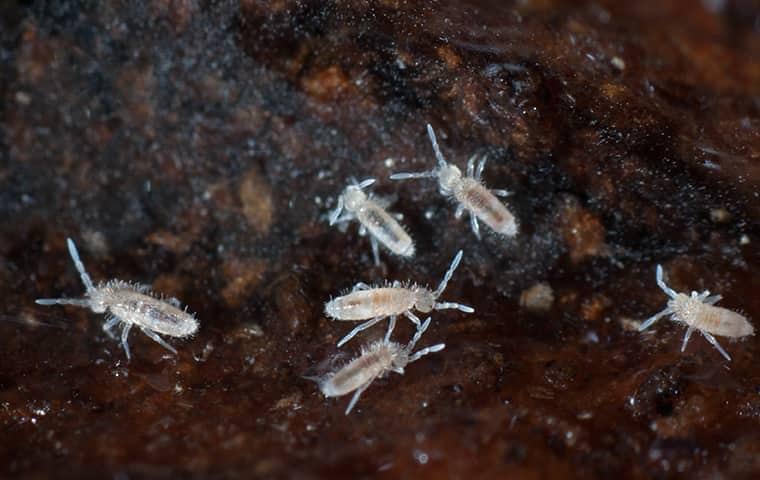If you're seeing tiny, springing insects in your yard, it is likely that you're seeing springtails. It is rare to find fleas springing around in the yard. A flea will wait in a cocooned state for a host to pass by, and then break free from its cocoon to jump on the host. It is selective in when it will do this because it wants to survive. It would need to see warm, exposed skin on your body. It isn't going to try to leap on your clothing. So it would be strange to see several fleas springing around in your yard. You would have to stumble upon a location where several fleas left their cocoons for a host and the host got away.
Springtails, on the other hand, are commonly seen outside. They congregate together in damp areas and begin springing into the air when they are disturbed. They don't have to worry about successfully leaving a cocoon to jump on a host. They feed on organic matter.
Understanding the behavior patterns of fleas and springtails helps to make identification easy but there are circumstances that can throw you a curveball. You may have to capture one of those insects and examine it to see if it is a flea or a springtail.
How do you capture a springing insect?
If there are enough of them, you can just lay a piece of tape down on them and snatch a few up. You may also leave a sticky trap in the area and catch some. If neither of these work, you might have to attract them to a trap to catch them. Insects are drawn to warmth. If you set up a light with a shallow bowl of soapy water underneath, you're likely to catch some of those pests. They'll jump toward the light bulb and fall into the soapy water.
Identification
Once you have a specimen, you'll need to inspect it. One of the easiest ways to differentiate a flea from a springtail is to look for antennae. Springtails have obvious antennae. The antennae on fleas are difficult to see. You may also examine the coloration. Fleas are reddish-brown. Springtails are multi-colored.
These two characteristics should help you figure out what insect you're dealing with in your yard, but if you need a second opinion, we're happy to help. We can do a free home evaluation and come and take a look or you can visit our Ask a Bug Pro page and upload a photo to us. We'll have our in-house entomologist take a look at it. Our Hendersonville pest control experts are very familiar with the pests that plague our customers throughout Middle Tennessee.
When Springtails or Fleas Get In
Both of these insects get into our homes mostly during the warm months of the year, May and June being their most active months. Springtails get in through gaps and cracks in exterior walls when they are lured near homes by damp conditions and are commonly found around window sills and potted plants. Seal your exterior walls and dry your foundation perimeter to reduce these insects. Fleas get into homes by hitchhiking on animals. While rodents can bring fleas into any home, homeowners with pets are more susceptible to flea infestations because pets don't just bring fleas in, they bring them up close and personal. Flea control products for your pets are the frontline defense against flea infestations.
If you ever have trouble with fleas or springtails, remember that All-American Pest Control is available to assist you with our home pest control services in Hendersonville.
Contact Us for a Free Home Evaluation
Frequently Asked Questions
Can fleas live in my yard?
Although you're unlikely to see fleas jumping around your yard, yes, fleas often thrive in shaded, damp areas of your yard, particularly where pets or wildlife frequent. Keeping your lawn well-trimmed and using flea treatments in outdoor areas can help reduce flea populations.
Are fleas and springtails dangerous to humans?
While fleas primarily target animals, they can bite humans, causing itchy red welts. In some cases, fleas can transmit diseases like murine typhus and cat scratch fever, making flea prevention crucial for both pets and people. Springtails do not bite or sting. They do not cause any harm to humans or pets.
Your Trusted Nashville, TN Pest Control Experts
Since 1961, All-American Pest Control has been your go-to team of trusted pest experts for homes, businesses, and home builders throughout Nashville and Middle Tennessee. Our expert team offers termite treatments, mosquito reduction, rodent removal, ant and spider control, and wasp nest removal—keeping your property protected year-round. As a local, family-owned company, we take pride in offering reliable, professional pest solutions with outstanding customer service.
We proudly serve: Adams, Ashburn, Barren Plains, Bethpage, Bransford, Castalian Springs, Cedar Hill, Coopertown, Cottontown, Cross Plains, Gallatin, Goodlettsville, Greenbrier, Hartsville, Hendersonville, Madison, Millersville, Orlinda, Pleasentville, Portland, Ridgetop, Springfield, Westmoreland, White House, and the entire Robertson County, Sumner Country and Greater Nashville areas.
For trusted pest control in Nashville, TN, and these surrounding communities, contact All American Pest Control today! Call (615) 824-8814 or schedule a free home evaluation.
 1435 Reviews
1435 Reviews


